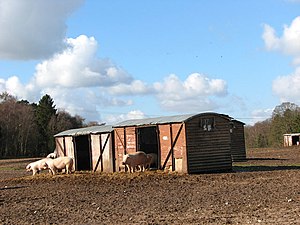
Farrowing huts are specialized shelters designed for sows (female pigs) to give birth and nurse their piglets. These structures provide a safe and comfortable environment for both sows and piglets, promoting animal welfare and productivity in pig farming. This page explores the design, benefits, and best practices for using farrowing huts in modern agriculture.
Design of Farrowing Huts
Farrowing huts are typically small, enclosed structures that offer protection from the elements and predators. Key design features include:
- Size and Shape: Huts are usually dome-shaped or A-frame structures that provide ample space for the sow to move around and lie down comfortably.
- Materials: They are constructed from durable materials such as galvanized steel, wood, or heavy-duty plastic to withstand harsh weather conditions.
- Ventilation and Insulation: Proper ventilation is essential to maintain air quality and temperature control, while insulation helps keep the hut warm during colder months.
- Accessibility: The design includes easy access for the farmer to monitor and care for the sow and piglets, with doors or panels that can be opened or removed.
Benefits of Farrowing Huts
- Animal Welfare: Farrowing huts provide a safe and comfortable environment for sows to give birth and nurse their piglets, reducing stress and improving overall health.
- Reduced Piglet Mortality: The enclosed space protects piglets from being accidentally crushed by the sow, a common cause of piglet mortality.
- Improved Hygiene: Huts help maintain a cleaner environment, reducing the risk of disease and infection.
- Cost-Effective: Farrowing huts are relatively inexpensive to construct and maintain, making them a cost-effective solution for small and large pig farms.
Best Practices for Using Farrowing Huts
- Location and Placement: Huts should be placed in well-drained areas to avoid water accumulation and ensure dry bedding. Grouping huts in clusters can facilitate management and monitoring.
- Bedding: Providing ample bedding, such as straw or wood shavings, is crucial for comfort and insulation. Bedding should be changed regularly to maintain cleanliness.
- Monitoring and Maintenance: Regular checks are essential to ensure the well-being of sows and piglets. Maintenance includes cleaning and repairing any damage to the huts.
- Weaning and Transition: As piglets grow, they should be gradually introduced to outdoor environments to acclimate them to pasture or larger pens.
Challenges and Considerations
- Climate Adaptability: In extreme climates, additional measures such as heating or cooling may be necessary to maintain optimal conditions within the huts.
- Predator Protection: In areas with high predator activity, additional fencing or security measures may be required to protect piglets.
- Space Requirements: Adequate space is needed to accommodate multiple farrowing huts, which may be a limitation for smaller farms.
See also
- LCA of Pig Farming
- Animal shelters
External links
- Building a Farrowing Hut - richsoil.com article with pictures of a farrowing hut in various stages of construction.
- farrowing hut - permies.com forum thread for questions on farrowing huts.